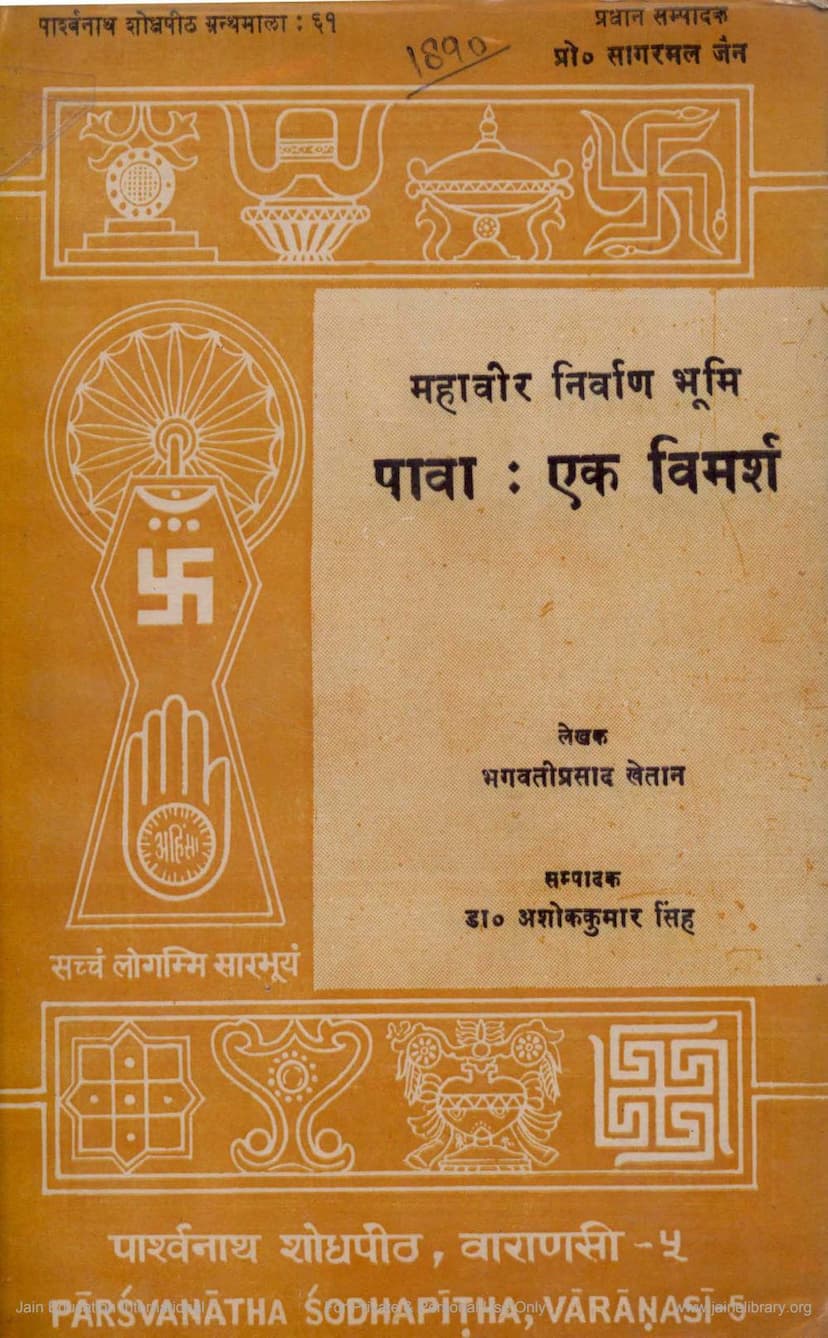Mahavira Nirvan Bhumi Pava Ek Vimarsh
Added to library: September 2, 2025

Summary
Here's a comprehensive summary of the Jain text "Mahavira Nirvan Bhumi Pava: Ek Vimarsh" by Bhagwati Prasad Khetan, based on the provided pages:
Book Title: Mahavira Nirvan Bhumi Pava: Ek Vimarsh (Mahavira's Nirvana Place Pava: A Discussion) Author: Bhagwati Prasad Khetan Publisher: Parshwanath Shodhpith Varanasi Catalog Link: https://jainqq.org/explore/002135/1
This book, "Mahavira Nirvan Bhumi Pava: Ek Vimarsh," is a scholarly work by Bhagwati Prasad Khetan, published by Parshwanath Shodhpith Varanasi. It is dedicated to identifying the precise historical location of Pava, the place where Lord Mahavira, the 24th Tirthankara of Jainism, attained his Nirvana (liberation).
Central Theme and Author's Argument:
The core of the book is Bhagwati Prasad Khetan's diligent research and argument that Padrauna (located in the Deoria district of Uttar Pradesh) is the authentic ancient Pava. Khetan undertook extensive research, examining historical, geographical, literary, and archaeological evidence to support his claim.
Key Issues and Scholarly Debate:
The book acknowledges that the exact geographical location of Pava has been a long-standing and complex problem, with a lack of consensus among scholars. Historically, several locations have been proposed:
- Traditional View: Some scholars link Pava to a site near Rajgir in Bihar, south-west of the Ganges.
- Alternative View: Other scholars suggest Pava was located north of the Ganges, between Vaishali and Shravasti, near the Gandak River.
- Western Scholars' Findings: Research by Western scholars pointed to two main possibilities:
- Fazilnagar-Sathiyanv: Located in the Deoria district.
- Padrauna: Also located in the Deoria district.
Khetan's meticulous work focuses on refuting the claims for other locations and presenting a strong case for Padrauna.
Author's Methodology and Evidence:
Khetan's research is multi-faceted, drawing upon:
-
Literary Evidence:
- Jain Literature: Analysis of texts like the Kalpa Sutra, which mentions "Majhima Pava" (Middle Pava) and its ruler Hastipal. Other Jain texts like the Avashyak Churni and Trishashti Shalakapurusha Charitra are also consulted.
- Buddhist Literature: Examination of texts like the Digha Nikaya, particularly the Mahaparinibbana Sutta, which describes Buddha's last journey and his stop at Pava, where he accepted the final alms from Chundakarma. The text also mentions the significance of Pava as a pilgrimage site declared by Buddha.
- Other Texts: References to texts like the Mahabharata, Ramayana, and Puranas are also considered to understand the historical and geographical context.
-
Archaeological Evidence:
- The book discusses findings from excavations and surveys, including the identification of archaeological remains, sculptures, pottery, and inscriptions.
- General Alexander Cunningham's early surveys and identification of Padrauna are highlighted.
- The book critically examines the findings at sites like Sathiyanv-Fazilnagar, concluding that archaeological evidence (like the discovery of a seal with the inscription "Shreshthigram" instead of "Pava") does not support these locations as Pava.
- The author discusses the significance of the archaeological mound at Padrauna itself, citing the discovery of various sculptures, including a significant Jain sculpture believed to be of the 10th-11th century.
-
Geographical and Linguistic Analysis:
- Khetan analyzes the geographical context, including the proximity to rivers like the Gandak (referred to as Sadānira, Mahānadi, etc. in ancient texts), which is crucial for understanding ancient routes.
- He explores the etymology of the name "Pava" and its possible connections to local place names, including Padrauna.
- The book delves into the ancient routes and geographical locations mentioned in Buddhist and Jain texts, correlating them with modern geography to pinpoint Pava. The significance of the ancient road connecting Vaishali and Kushinagara, and Padrauna's strategic location on this route, is emphasized.
Key Scholarly Contributions and Endorsements:
The book is endorsed by eminent scholars like Padma Bhushan Pt. Dalsukh Bhai Malvania and Prof. Sagarmal Jain, who praise Khetan's dedication and the meticulous nature of his research. They acknowledge that while the identification of Padrauna as Pava might not yet be universally accepted by the academic community, Khetan's arguments are robust and necessitate serious consideration by historians and Indologists.
Challenges and Significance:
The author acknowledges that his work is a significant undertaking for someone from a business background, demonstrating a deep commitment to historical research. The book aims to resolve a long-standing historical debate and provide a scientifically grounded identification of Pava, which would be a major contribution to Jainology and ancient Indian history.
Structure of the Book:
The book is organized into several chapters, covering:
- Introduction to Pava (Etymology, Importance, Decline)
- Literary Evidence (Jain and Buddhist texts)
- Mallarashtra (Historical context of the region where Pava was located)
- Various Theories on Pava's Location
- Pava-Padrauna Analysis
- Archaeological Survey of Padrauna
- Ancient Buddhist Routes
- Pava Route Research
- Conclusion
Overall Impact:
"Mahavira Nirvan Bhumi Pava: Ek Vimarsh" is presented as a path-breaking work that challenges existing assumptions and presents a compelling, evidence-based argument for Padrauna as the true site of Lord Mahavira's Nirvana. It is a testament to the author's deep scholarship and his dedication to uncovering historical truths. The book encourages further research and scholarly debate on this crucial aspect of Jain history.